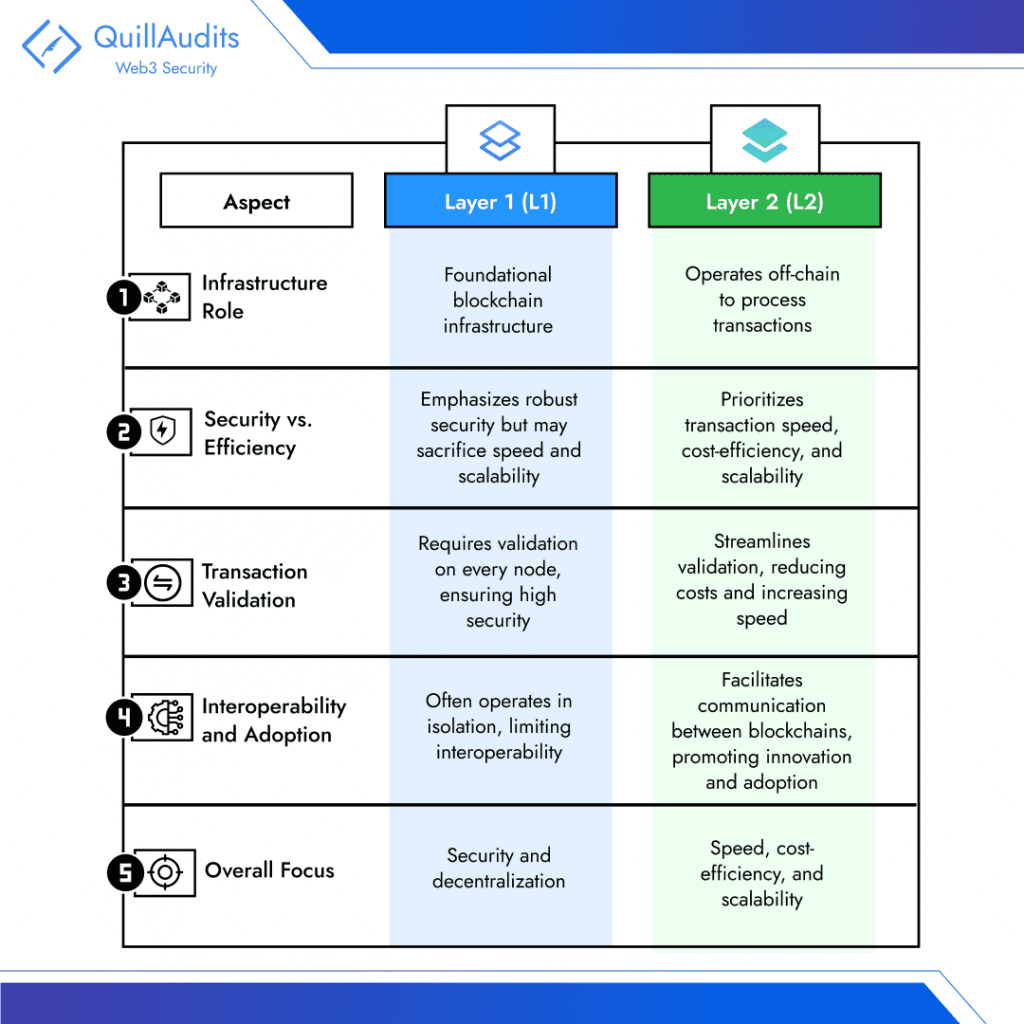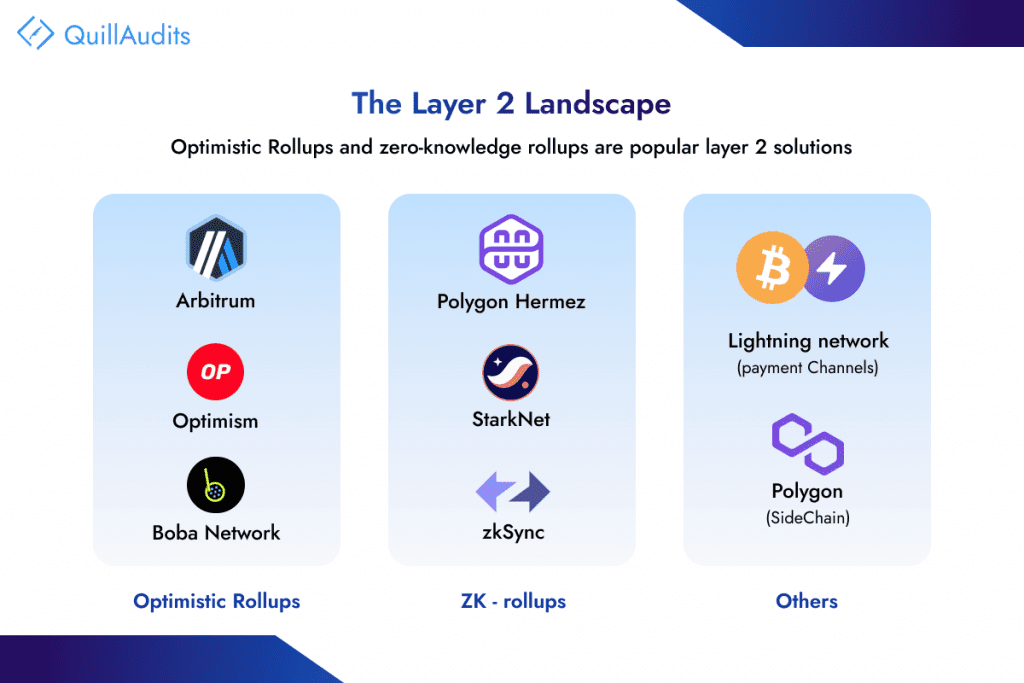In the ever-evolving world of technology, change is the name of the game. Think about how our humble landline phones transformed into sleek smartphones, all thanks to changing user demands.
Similarly, blockchain technology also needed something better, and that led to the creation of Layer 2.
Layer 1 (L1) is the foundational infrastructure of a blockchain that handles essential tasks like verifying transactions, creating blocks of data, and ensuring consensus.
On the other hand, Layer 2 (L2) solutions work alongside and off-chain from the main blockchain (L1) to process transactions faster and at a lower cost.
With this understanding, let’s delve into the depths of the blockchain layers and learn about the intricate challenges, future trends, and much more. Let’s get started!
Comparative Analysis of L1 and L2 Blockchain Solutions
It’s crucial to understand the distinctions between the two layers with unique strengths catering to different aspects of the blockchain ecosystem.
Security: Layer 1 blockchains serve as the bedrock of security and decentralization. They establish the core infrastructure, including consensus mechanisms, cryptographic methods, and a vast network of nodes. These elements create a highly secure and decentralized environment.
However, this robust security often comes at the expense of speed and scalability.
Transaction Capabilities: Transaction speed and cost are critical to heightened user experience. Layer 1 blockchains, while secure, typically suffer from high costs and slow transaction speeds. This is due to the need to validate each transaction on every node, which can be resource-intensive.
Layer 2 solutions address this issue by offloading certain transaction components from the main blockchain. This optimization leads to faster validation and lower transaction costs, making Layer 2 the go-to choice for efficiency-conscious users.
Fuelling Adoption: Blockchain interoperability is a major challenge, with many networks existing in isolation. L2 solutions emerge as catalysts for change by enabling different blockchains to communicate and collaborate. This leads to a more interconnected and unified blockchain ecosystem, pacing innovation in use cases and applications.
Moreover, Layer 2 solutions enhance blockchain adoption by enhancing accessibility and user-friendliness.
From this analysis, it is clear that Layer 1 shines in terms of security and decentralization, while Layer 2 excels in transaction speed, cost-efficiency, interoperability, and driving blockchain adoption.



L1 Challenges: What Lies Beneath?
Layer 1 is fueled by a synergy of components, including consensus, smart contracts, networks, and cryptography, all working synchronously to drive its functionality. However, this also implies that each of these elements has unique challenges to deal with.
Consensus ensures the state of the blockchain, yet they are susceptible to 51% attacks, Sybil attacks, nothing-at-stake dilemmas, and so on, threatening the trust in consensus mechanisms.
Smart contracts, the dynamic code scripts powering L1 protocols, are prone to coding flaws such as re-entrancy, integer overflow and underflow attacks, front-running, gas optimization and whatnot.
Apart from this, Eclipse attacks arising from Peer-to-peer networks and private key leaks disrupt the security fortress in L1 solutions.
L2 Challenges: What Lies Beneath?
Transferring assets or data between L1 and L2, which we call “bridging,” can be very complex. This opens the door to vulnerabilities, making it necessary to ensure secure transitions without asset or data loss.
When it comes to data, the integrity and constant availability of off-chain data related to L2 transactions are crucial. If this data becomes inaccessible or lost, verifying and settling transactions could become a daunting challenge, potentially disrupting L2 operations.
The Security Problems in L2 include malicious actors attempting to manipulate data to deceive users and, apart from this, unique challenges specific to L2 solution, whether it’s State Channels, Plasma, or Rollups, possess due to its distinct design nuances.
Case Studies of Layer 2 Solutions
Here are some case studies highlighting the success and impact of L2 solutions:
Arbitrum Dominance: Arbitrum is a prominent Layer 2 blockchain that has gained significant traction. It stands out by bridging more than four times the amount of Ethereum (ETH) compared to its closest competitor, Optimism.
With over 2M ETH bridged, Arbitrum has proven its scalability and efficiency.
Polygon: Polygon, another Layer 2 solution, has garnered attention for its adoption by well-known brands and platforms venturing into the Web3 and NFT space.
Companies like Starbucks, Meta, and Reddit have embraced Polygon. This indicates Polygon’s appeal as a Layer 2 choice for large-scale applications and traditional brands.
Immutable X: Immutable X is a Layer 2 solution with a specific focus on gaming and non-fungible tokens (NFTs). While it may not be as well-known as others, it occupies a unique niche.



Emerging Layer 1 Solutions
In addition to Layer 2 solutions, emerging Layer 1 blockchain are shaping the blockchain landscape with innovative features. Here are some noteworthy emerging L1 solutions:
Cronos: Cronos is an emerging L1 blockchain with several innovations, including Ethereum Virtual Machine (EVM) compatibility, integration with Cosmos, interoperability features, and a proof-of-authority (PoA) consensus mechanism. These elements position Cronos as a blockchain to watch in terms of scalability and cross-chain functionality.
Avalanche: Avalanche distinguishes itself with leaderless consensus protocols and the use of Directed Acyclic Graphs (DAG) to organize transactions. These innovations improve scalability and performance, making Avalanche a promising contender in the blockchain space.
Aptos and Sui: Aptos introduces elements like the AptosBFT consensus algorithm and a parallel execution framework called Block-STM. Sui, on the other hand, incorporates creative ideas such as split transactions, dual consensus mechanisms, and Sui Move. Both Aptos and Sui showcase innovative approaches to blockchain scalability.
Some Light Into The Future Trends
The future of blockchain technology is marked by several trends that will shape its evolution. Be it the multichain world, where different blockchains interoperate seamlessly. This trend opens up opportunities for broader blockchain adoption and new use cases, especially in digital asset trading.
While on the other Layer 2 scaling solutions are expected to drive advancements in the decentralized finance (DeFi) sector. Faster transaction times and lower costs will enable more complex DeFi protocols, making them accessible to a wider audience.
Despite scalability efforts, security and decentralization remain paramount. So, the Layer 2 solutions need to maintain high levels of security while enhancing efficiency.
Closing Thoughts
In a nutshell, the blockchain landscape is evolving rapidly, with Layer 2 solutions addressing scalability issues, emerging Layer 1 blockchain introducing novel features, and future trends focusing on scalability, security, and a multichain ecosystem. These developments promise a transformative future for blockchain technology across various industries.






















